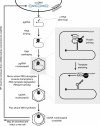Unveiling the roles of HBV polymerase for new antiviral strategies
- PMID: 25893003
- PMCID: PMC4399241
- DOI: 10.2217/fvl.14.113
Unveiling the roles of HBV polymerase for new antiviral strategies
Abstract
Infection with HBV is common worldwide, with over 350 million chronic carriers. Chronic HBV infection is associated with cirrhosis and hepatocellular carcinoma. All currently available oral antivirals are directed against the HBV polymerase enzyme, a reverse transcriptase. HBV polymerase contains several important domains and motifs which define its functions and reveal ways to further target it. This enzyme executes many functions required for the HBV replication cycle, including viral RNA binding, RNA packaging, protein priming, template switching, DNA synthesis and RNA degradation. In addition, HBV polymerase must interact with host proteins for its functions. Future therapeutics may inhibit not only the DNA synthesis steps which are carried out by the reverse transcriptase domain (as all current antivirals do) but other domains, functions and interactions which are essential to the HBV replication cycle.
Keywords: HBV; antiviral targets; drug resistance; replication cycle; reverse transcriptase.
Figures



References
-
- Summers J, Mason WS. Replication of the genome of a hepatitis B – like virus by reverse transcription of an RNA intermediate. Cell. 1982;29(2):403–415. - PubMed
-
- Bond W, Favero M, Petersen N, Gravelle C, Ebert J, Maynard J. Survival of hepatitis B virus after drying and storage for one week. Lancet. 1981;317(8219):550–551. - PubMed
-
- McMahon BJ, Alward WLM, Hall DB, et al. Acute hepatitis B virus infection: relation of age to the clinical expression of disease and subsequent development of the carrier state. J. Infect. Dis. 1985;151(4):599–603. - PubMed
Grants and funding
LinkOut - more resources
Full Text Sources
Other Literature Sources
